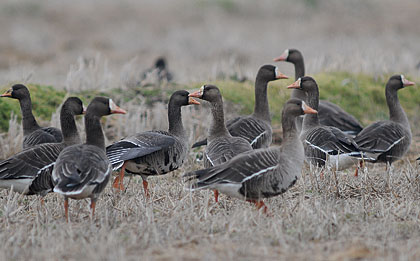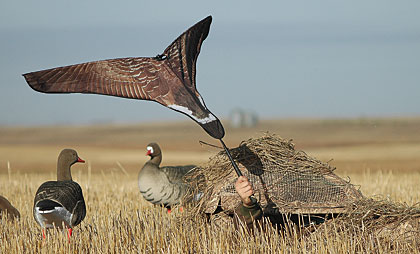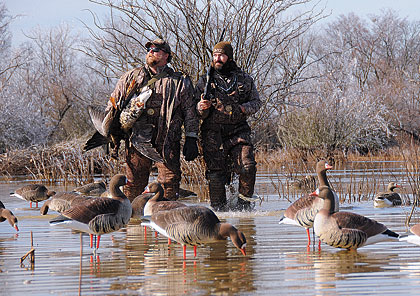December 10, 2010
By Will Brantly
Yodeling whitefronts enchant goose hunters.
By Will Brantly
 Look for specks in the same general areas snow geese frequent: muddy crop fields dotted with shallow puddles and patches of grass. |
A hunter sips coffee and double-checks his meager spread in the legal light of a newly minted day. Six realistic full-bodies are positioned in the mud 20 yards downwind.
The first yodels are distant, but unmistakable. The hunter discards the coffee and hides the still-steaming cup in his laydown blind. He yodels back, and the bird answers. Call, answer.
Advertisement
Call. Answer.
A light fog and the blind's flaps obscure his vision. He doesn't dare raise his head to look, but he can tell the bird is close. The hunter's call takes a considerable burst of air to operate, but he can't slow down now. He continues to call. The goose continues to answer.
Advertisement
The lead bird is still talking when they finally appear -- three geese -- wings set, gliding toward the decoys. The hunter rises deliberately, shoulders his gun and focuses on the head of the trailing bird. It folds upon a single, muffled shot in the open rice field. Before the splash, the hunter swings on another bird. Two more shots -- a second goose falls.
Bright white rings at their bases accentuate pink bills. The first bird is young. Plucked and roasted, it will make a fine supper this evening. The other is mature and wears a suit of rich black bars across its breast. The adult goose is just the specimen the hunter has been looking to put on the wall.
Alone in this rice field, the hunter can hear volleys of gunfire in the distance. Other hunters are enjoying flocks of ducks and camaraderie. This hunter has achieved a limit in minutes, and is now picking up decoys. But offering him the promise of two limits of greenheads in exchange for this experience would be a waste of breath.
Greater white-fronted geese, often called specklebellies or just specks, are fascinating birds with a cult-like following of hunters. No other waterfowl species hunted in North America interacts so plainly with a hunter and his call. The geese are stunning to the eye and delectable on the table. Bag limits for specks are typically modest in most states (often two per day), so many hunters regard a speck in the bag as a trophy bird. Rightfully so.
 Specks feed in open fields and shallow marshes on a variety of vegetation. Rice fields and shallow mud flats are particularly attractive on the wintering grounds, but they'll readily hit other crop fields as well. |
Speck Specifics
For the most part, white-fronted goose populations are stable. Specklebellies making up the Mid-continent population winter primarily in the southern United States, mostly west of the Mississippi River. The rice fields and open marshes of Arkansas, Louisiana and Texas are prime wintering habitat. A Pacific population of specks winters in California and other areas along the West Coast. Both the Mid-continent and Pacific whitefront populations are estimated at about 600,000 birds.
A subspecies of white-fronted goose, the Tule goose, winters almost exclusively in California. Populations of Tule geese are low. In fact, they are one of the least abundant of any goose subspecies, according to the Arctic Goose Joint Venture. Both Pacific and Tule white-fronted geese breed primarily in Alaska. The Mid-continent population has a wider breeding range, nesting primarily in tundra wetland habitat in northern Canada, Alaska, Russia and Greenland. A separate species of white-fronted goose, the lesser whitefront, is found in northern Asia and Europe. It is similar to the greater whitefront, but smaller as the name indicates.
Specks feed in open fields and shallow marshes on a variety of vegetation. Rice fields and shallow mud flats are particularly attractive on the wintering grounds, but they'll readily hit other crop fields as well. As with other goose species, breeding pairs and their offspring often remain in family groups during the course of the migration. Typically, you can expect to see specks in southern rice fields during the first weeks of November, just about the time the first flocks of snow geese arrive.
 A spread of full-body decoys with varied head positions will effectively draw the attention of specklebellies, although a persistent call or an eye-catching landing flag might be all you need. |
Muddy Water
Few hunters know more about specklebellies than Kelly Haydel of Haydel's Game Calls. Kelly, along with his brother, Rod, and father, Eli, has a long history of waterfowl hunting in the storied southwest Louisiana marshes of Cameron Parish. It is in the marsh, not in an open rice field, that Kelly Haydel really hits his stride when calling specks. But he has shot plenty of the geese over rice fields, too. Regardless of whether you are hunting fields or marshes, knowing a bit about preferred speck habitat enhances your scouting efforts.
Specks will feed in the same fields as snow geese, often at the same time, although the two species typically separate themselves. When prospecting for a good speck field, search for sloppy, muddy crop fields that have recently been picked and turned over. Sizeable puddles of muddy water in the field makes it even better.
"That turned-over ground allows the birds easy access to new, sprouting vegetation as well as the leftover crop," Kelly Haydel said. "Depending on the amount of food, a group of specks may feed in a field for a few days or a couple weeks."
Marsh geese are looking for areas to rest as much as areas to feed, but don't overlook the groceries there, either.
"Shallow areas with interspersed patches of grass and especially shallow or exposed mud flats seem to hold the most specks in the marsh," Kelly Haydel said. "They're much more productive than the deeper, more open ponds. The geese can walk up onto those mud flats and feed. We have several permanent blinds we hunt from in the marsh, but one in particular is always the most productive for specklebellies. It has just that type of broken, shallow habitat."
Decoy Strategies
"There are two ways to look at decoys for specklebelly hunting," Kelly Haydel said. "When we were growing up, Dad didn't like using decoys at all so that working birds would hopefully fly close, looking for the source of the call. But both Rod and I prefer to use at least a few decoys. In the marsh, we'll toss out a few floaters. Ideally, if there's a small, grassy island, we'll place a single full-body decoy on that. Regardless, you don't need a big spread of speck decoys in either a field or in the marsh to kill your limit."
When hunting a field in the early season, Kelly Haydel uses a dozen to 18 decoys. Late in the season, he might scale back to as few as two decoys.
Several companies produce a variety of speck decoys in full-body, floater and shell versions. In fields or mud flats, full-bodies are the way to go. They're pricier, of course, but worth the money. Most full-body decoys sport a variety of head and body positions, which definitely enhance their realism.
When hunting fields, Kelly Haydel arranges his spread so the alert sentinel decoys are on the perimeter, looking away from his blind.
"Working geese will instinctively look toward where the sentinel decoy is looking, so it's very important that their attention is focused away from your blind," he said.
Although conventional specklebelly wisdom says to segregate speck decoys from duck and snow goose decoys, it isn't an absolute requirement.
"I've watched content specks feed right alongside mallards and green-winged teal in refuges," Kelly Haydel said. "Don't be afraid to incorporate a family group of mallard decoys alongside your specks. In a field, full-body duck decoys definitely look realistic, and that spread setup isn't something birds are used to seeing most of the time."
Yodeling for Success
Calling to ducks is fun and effective, but day in and day out, it's not as important as a good spread of decoys. The opposite might be true with specks -- and that is one of the reasons they are so much fun to hunt.
"Hunting in the marsh, if I can hear a speck, I feel pretty confident in my chances of calling him in for a closer look," Kelly Haydel said. "Calling is your ace in the hole in the marsh. The birds are flying over a wide area that all looks the same, so calling to them allows them to really key in on your location. When I hear a speck, either in a marsh or field, I begin my sequence with a basic two-note yodel, although I may draw out the first note just a bit."
Like working a spring gobbler, the fun begins when a goose answers your calls. "When he answers me, I get into a dialogue with him," Kelly Haydel explained. "He calls, I answer back. Sometimes he'll skip a note, but I keep the same rhythm going, regardless. I don't know if they skip notes because they're drawing a breath or listening for you, but it's important to just keep going. Usually, they'll begin answering you again.
"I keep calling until I reach for my gun. Calling specks isn't like calling ducks, where you need to stop once they're committed and let them do their thing. If you've ever flushed geese from a field, you'll notice that just before they take wing, there is a moment of silence. So suddenly stopping your call when the geese are just shy of gun range can be like an alarm to them. I'll simply tone my yodels down and begin throwing some soft clucks into the sequence."
Many hunters use aggressive, rapid clucking as specks are closing the distance, but Kelly Haydel's style of clucking is more subdued.
"Specks that are content and feeding in a field make soft clucks and murmurs," he said. "So I back off on the volume and intensity of my clucks with working birds that are in close. Sometimes I switch calls. It's good to carry two speck calls with you, actually. One should have a big bore for 'power calling,' and then one should be a wood call or a call with a lighter reed for close-in work. With those two calls, you can run the full gamut of sounds."
In addition to calling, flagging is effective for grabbing the attention of distant specks. Actually, waving a flag can be effective for just about any type of waterfowl.
"Think about it," Kelly Haydel reasoned. "How many times have you stepped out of the blind to use the restroom or rearrange decoys and you're surprised by ducks and geese that sneak in? I think that added movement catches their eye from a distance, and they move in to investigate. So flagging isn't just effective for Canada geese. Typically, when I'm hunting specks I'm trying to pack as little gear as possible, so I just use a short landing flag."
Fowling Favorite
Specks can be somewhat elusive, difficult birds to hunt. It's rarely a high-volume shooting endeavor, and the bag limits are modest. But guys like Kelly Haydel hold these quirky geese in high regard.
"What I think makes specklebelly hunting so exciting is the fact that you don't have to have a spread of 500 decoys to be successful," he said. "I can take half-a-dozen decoys, a call and a decent location, and I feel pretty confident that I can go hunting and get my limit of two of the finest-eating waterfowl around."
Avid waterfowl hunter Will Brantley hails from Murray, Ky.

